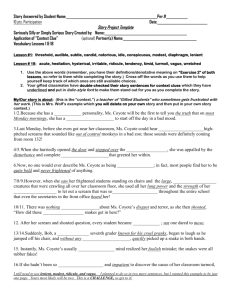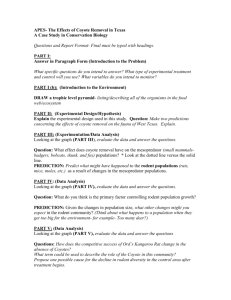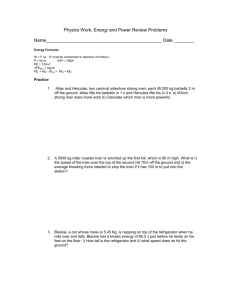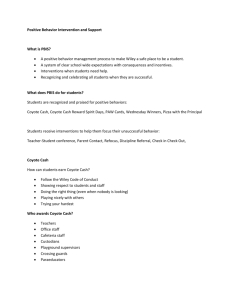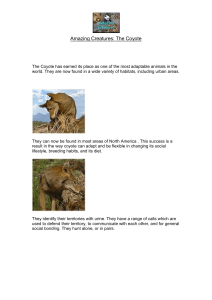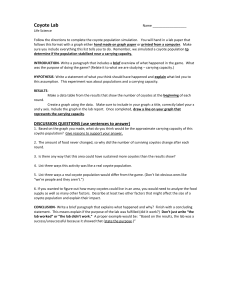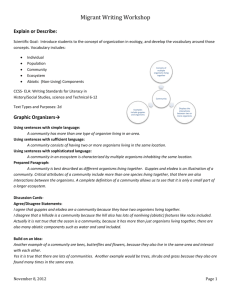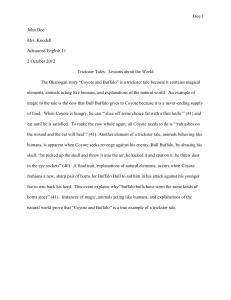3 generic Powerpoint Presentation for Writing W..
advertisement
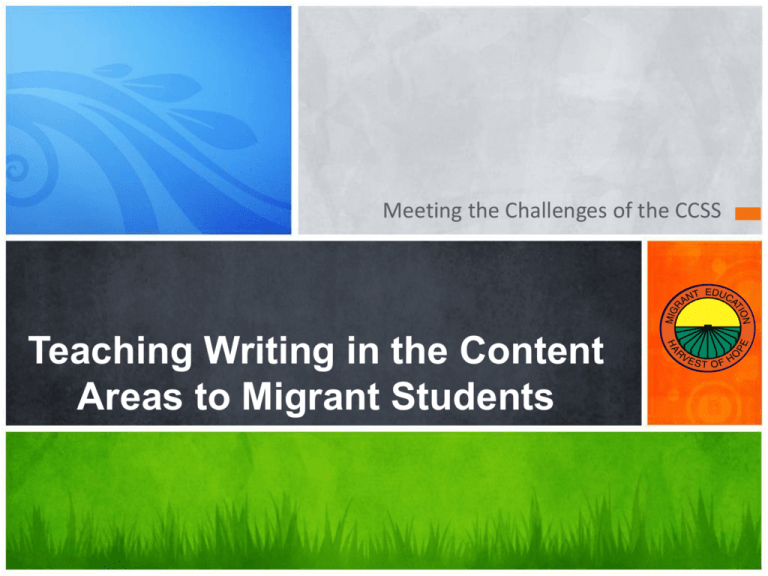
Meeting the Challenges of the CCSS Teaching Writing in the Content Areas to Migrant Students Presented by: The WA State Migrant Education Program Supporting migrant students in K-12 education Who Are You When Teaching Writing to Migrant Students? TODAY’S AGENDA • • • • • • • • • • • • • • • • • • • 8:00 AM Welcome/Introductions 8:15 AM Purpose 8:20 AM Review of Common Core State Standards in Writing 8:30 AM Review Handout Packet and Resources Provided 8:40 AM Workshop Outcome and Parking Lot 8:45 AM Inquiry into Participants’ Prior Knowledge--writing strategies and the needs of migrant students 9:00 AM Special considerations of Migrant Students in the Area of Writing: What the research says 9:15 AM Motivational and Cultural Writing Supports 9:30 AM BREAK 9:45 AM Challenge #1: Variety of text types TODAY’S AGENDA • 11:30 AM LUNCH…(on your own) • 12:30 PM Challenge #2: Notetaking and Organizing • 1:45 PM BREAK • 2:00 PM Challenge #3: Teaching the Writing Process a high yield strategy that can be applied to a variety of text types • 2:30 PM Challenge #4: Writing that Expresses Metacognition and Reflection • 2:45 PM Evaluation PURPOSE OF THIS WORKSHOP Provide participants with writing strategies that will support migrant students in analyzing and writing in a variety of text types as outlined in the Common Core State Standards. PURPOSE OF THIS WORKSHOP (continued) The focus of the strategies will be on two of the three text types outlined in the CCSS: 1. Argumentative 2. Informational or explanatory 3. Narrative OUTCOME OF THIS WORKSHOP Participants will be able to support migrant student reading and writing by utilizing 2-3 new strategies to support migrant students in analyzing and writing in the two text types that are the focus of this workshop. Common Core State Standards Let’s review the Common Core State Standards in Writing… Common Core State Standards Let’s review our materials for today… Tapping Into Background Knowledge—INQUIRY CHART IN TABLE TEAMS, PUT YOUR HEADS TOGETHER AND DISCUSS THE FOLLOWING TWO QUESTIONS: “What do I know about content area writing for migrant students?” …and “What is something I want to know about content area writing for migrant students?” Inquiry Chart WHAT IT LOOKS LIKE 13 Inquiry Chart HOW TO DO IT • Whole group, students “on the carpet” • Students turn and talk to discuss what they know about the topic • May use “call out” - children give their responses all together - lowers affective filter – teacher selects which response to record. • Use the language of the students – verbatim – model authentic revising and editing – validate student responses – use L1 (primary language) when possible • Process this chart regularly throughout the unit – correct misconceptions – cite sources – add new statements - model writing in context including mechanics 14 Inquiry Chart WHY DO IT? • Student centered – inquiry – motivation – sets purpose for learning • Access and focus on background of students • Fosters metacognition – “How do you know that?” • Uses the students’ existing language and prior experiences to develop reading, writing and listening skill • Model writing, revising, editing and citing sources • Assessment WHY A SPECIAL WORKSHOP FOR MIGRANT STUDENTS? What does the data and research tell us? Data for Washington State’s Migrant Students Let’s first look at how migrant students are doing in Writing… 17 Data from 2011 MSP Data from 2011 MSP Data from 2011 MSP Data from 2011 MSP Why a special migrant writing workshop? What do we already know about migrant students and families? What research is available to inform us? 22 Seven Areas of Concern for Migrant Students 1. 2. 3. 4. 5. 6. 7. Educational Continuity Instructional Time School Engagement English Language Development Educational Support in the Home Health Access to Services 23 Seven Areas of Concern for Migrant Students • 1: Educational Continuity – When students move from place to place they often encounter different expectations, curriculum, course requirements, assessment, etc. This is especially difficult for high school students who are trying to accrue credits and meet graduation requirements. Seven Areas of Concern for Migrant Students • 2: Instructional Time – When students move they often miss instructional days between the time they leave one school and finally enroll in a new school. Seven Areas of Concern for Migrant Students • 3: School Engagement – Research shows that feeling part of the school community is an important protective factor and predictor of school success. When students change schools frequently, they often feel like the new kid who doesn’t really belong Seven Areas of Concern for Migrant Students • 4: English Language Development – Parents of MEP students often do not speak English. Students are often English Language Learners. Seven Areas of Concern for Migrant Students • 5: Education Support in the Home Parents often work long hours: • living conditions are often crowded and noisy • Often there are no books in the home • Often parents have low levels of education Seven Areas of Concern for Migrant Students 6: Health MEP students frequently have unmet health needs including dental and vision issues 29 Seven Areas of Concern for Migrant Students 7. Access to Services Families often do not know how to access community services or participate in the American school system. They are often isolated because of lack of transportation or language barriers 30 Build Background and Schema Assumptions must not be made about the background or schema that our migrant students have Additive versus Subtractive (Cummins, Krashen, Escamilla, Wolfe, Jensen, Hart and Riley, Payne, Graves, Caulkins) 31 Provide Models and Experience Don’t ask student to write in a genre for which they have no models Allow for a common experience to set students up for success (To, With, and By- Margaret Mooney, I, We, You – Anita Archer, Gradual Release of Responsibility-Project GLAD) 32 Scaffold for Support Aim for the Zone of Proximal Development (ZPD differentiation) Provide scaffolds that are culturally relevant and sensitive Provide scaffolds that are intended to make the learning accessible and increases the rate of learning (Vygotsky, Bransford, J., Brown, A., & Cocking, R, Ellis, E., Larkin, M., & Worthington, L Hartman, H., Jaramillo, J , McKenzie, J. ) 33 Provide Many Opportunities for Discourse Oral language development comes prior to written communication Use Collaborative and Individual Structures Discourse Patterns Teacher to Student Student to Student T-S-S-S-T-S-T-S-SCultural and Linguistic Differences (Kaplan, Cardenas, Tannen, King, O’Donnell, Chan) 34 Motivational and Cultural Writing Supports “Students live in two worlds: home and school. If these two worlds do not recognize, understand, and respect each other, students are put in a difficult predicament.“ Alma Flor Ada 35 Motivational and Cultural Writing Supports Access the home and family to provide connections and springboards for writing Access the expertise within the family and community to share writing, experience, and information (Ada, A. F., Moll, L. CG Vélez-Ibáñez, JB Greenberg) 36 Motivational and Cultural Writing Supports Home School Connections Super Scientist Awards (Brechtal, M. & Haley, L.) 37 Cause and Effect Cause and Effect EnvironmentalMelting of the Ice Cap What could be some of the effects caused by global warming on the polar ice cap? Extinction of species (i.e . Polar Bears) Over Population of a species, unbalanced Cause and Effect Global warming may have a significant impact on planet Earth. Some of the major effects of global warming may cause and be traced to the environmental changes that may result in the melting of the polar ice cap. Due to the warming of the earth, the polar ice cap will melt; thus causing extinction of species such as the Polar Bear. The end result is that there may be a change in the trophic levels in the polar ice cap . This will potentially lead to the overpopulation of a species, resulting in an environmental imbalance. EXPLAINING AND DESCRIBING IN SCIENCE Different Roles in an Ecosystem Sorting out life: What do these words mean? • Get a deck of ecosystem sorting cards. • Work with a partner to sort the cards into different piles. • The piles should represent: – Individuals – Populations – Communities – Ecosystems – Abiotic (Non-Living) Components Using Discussion Cards… Agree/ Disagree Statements • Simple: “I agree because…” Sufficient: “I don’t think that’s right since…” Sophisticated: “Another way to look at it is…” Build on an Idea • Simple: “Another idea is…” Sufficient: “Yes, but it’s also true…” Sophisticated: “Wouldn’t that also mean…” Possible Graphic Organizers Consists of multiple organisms living together Community Examples include guppies and organisms Displays the interactions between two or more organisms Using Graphic Organizer Card To Define Parts Of An Ecosystem • Using sentences with simple language: A community has more than one type of organism living in an area. • Using sentences with sufficient language: A community consists of having two or more organisms living in the same location. • Using sentences with sophisticated language: A community in an ecosystem is characterized by multiple organisms inhabiting the same location. To open To explain or describe To support your ideas To close _________________ is best described as _____________________. To define ____________, it is necessary to understand_____________. __________ is known for ____________ and is important because ___________. ______________ is an illustration of ______________. _________________ is frequently referred to ________________. Critical attributes of ______________ include __________ and ___________. A defining characteristic is ___________________ and ____________. The key components are ____________ and __________________. An explanation of ________________ provides insight into ____________. A complete definition of ____________ allows us to ______________. Using a frame for describing/explaining: A community is best described as different organisms living together. Guppies and elodea are an illustration of a community. Critical attributes of a community include more than one species living together, and that there are also interactions between the organisms. A complete definition of a community allows us to see that it is only a small part of a larger ecosystem. Using Writing Frames Observational Organizer Think of properties you can see such as size, shape, color, lines, texture, pattern, behavior… “I observed…” “I noticed…” “It reminds me of…” “This is so because…” “I am curious about…” Observational Organizer Think of properties you can see such as size, shape, color, lines, texture, pattern, behavior… I observed… Think of the other senses of smell, sound, touch, and perhaps taste! I noticed… Connect it with something that you already know. Add more detail as needed. It reminds me of… Be curious and ask questions you could investigate. I am curious about… It surprised me that… OR … I wonder what would happen if… This is so because… Observational Organizer: Examples I observed… I observed with the community group that there was more than one type of living organism represented in the card. I noticed… I also noticed that the organisms might be all plants, all animals or even a combination of a plant and animal. It reminds me of… A community reminds me of going to the fair. This is so because… This is so because you see goats, sheep and rabbits all in the same barn. I am curious about… I am curious about other places you would find communities. It surprised me that… OR … I wonder what would happen if… Putting it all together I observed with the community group that there was more than one type of living organism represented in the card. I also noticed that the organisms might be all plants, all animals or even a combination of a plant and animal. A community reminds me of going to the fair. This is so because you see goats, sheep and rabbits all in the same barn. I am curious about other places you would find communities. COMPARE & CONTRAST Using energy flow to note the similarities and differences in an ecosystem . Food Chains How does the energy flow? The arrows show the direction of energy flow in a system. Food Chain Mono Lake What are the Organisms in the Mono Lake Ecosystem? 1. Read and become familiar with the organisms and their natural history. 2. Organize the cards on your table picture side up. 3. Use arrows to show feeding relationships between organisms and energy flow through the system. What are the Organisms in the Mono Lake Ecosystem? 1. Visit each others’ food chains. 2. Take the “Ask a Question” card with you. 3. Practice asking different levels of language as you ask questions. Compare - Contrast California Gull ~ Coyote Box and T-Chart Box: Illustrates the similarities between two species T-Chart: Defines the differences using a one to one correspondence between two species California Gull Coyote Compare - Contrast Box and T-Chart Box: Illustrates the similarities between two species California Gull ~ Coyote Both animals are part of the Mono Lake Ecosystem Similarly, they both are scavengers and will eat carrion (dead or decaying flesh) California Gull T-Chart: Defines the differences using a one to one correspondence between two species Coyote Compare - Contrast Box and T-Chart Box: Illustrates the similarities between two species T-Chart: Defines the differences using a one to one correspondence between two species California Gull ~ Coyote Both animals are part of the Mono Lake Ecosystem Similarly they both are scavengers and will eat carrion (dead or decaying flesh) California Gull Coyote Makes nests in hollows Lives in a den that is in ground marked by their scent Predators include coyotes, raccoons, weasels and Caspian terns Eggs are laid in May and hatch in June Predators include wolves Mating occurs in February/March and pups are born in April/May Using Transition Words… Use the language of compare and contrast when you are asked to: discuss the similarities and differences choose the best option identify common characteristics but contrary in common however same on the other hand yet both as opposed to unlike share a distinction between like each share the same similarly produced just alike whereas although in contrast compared to Compare-Contrast Compare Statements Contrast Statements • Simple language: The gull and the coyote are the same because they both live in the Mono Lake ecosystem. • Simple Language: California gulls make their nests in hollows of the ground unlike the coyote that makes a den with their scent somewhere in their hunting area. • Sufficient Language: The gull and the coyote are similar because they are both considered scavengers in the ecosystem sometimes eating carrion. • Sufficient Language: Gulls are hunted by many animals such as coyotes, other small mammals and even birds in contrast the coyote is only hunted by one animal, the wolf. • Sophisticated Language: Common attributes of the gull and the coyote include a diet of carrion, dead or decaying fish. • Sophisticated Language: The reproductive habits of the coyote and gull are different. Gulls will lay their eggs in May and hatch in June, whereas coyotes mate during February and March and birth their young in April and May. Using a Compare / Contrast Frame… To open By comparing the _________ and the _______, it becomes clear that… To compare or contrast Although ______ and ______ are _____, _________ is ________. To support your ideas One similarity / difference is __________ . To close By comparing _____ to __________, we learn ____________. Prepared paragraph using frame to show differences: By comparing the gull to the coyote, it becomes clear tha, even though they live in the same ecosystem they are organisms with different needs. Although gulls and coyote are both organisms in the Mono Lake ecosystem, each organism has different predators. One difference is that the gull has many predators including the coyote and the Caspian tern, whereas the only predator the coyote has is the wolf, which is not part of this ecosystem. By comparing their predators, we learn that gulls have more predators in this location that the coyote. Compare and ContrastStart with how things are the same or The _____ and the ______ are the same because they both similar. ___________. Add more details as needed. The coyote and gull are the same because they both live in the Mono Lake Ecosystem. In addition, they both ________________. In addition, they both tend to be scavengers and will sometimes eat on the dead and decaying flesh of animals known as carrion. Explain how they are different. You can compare the same property or characteristic in the same sentence. Use “and”, “but”, or “whereas” to set up the contrast. Add more detail as needed. They are different because the ______, but the ______ does not. The gull and coyote are different because the gull lays eggs in the spring, but the coyote gives birth to live pups. Also, the ________, whereas the ________________. Also, the gull has many predators within the Mono Lake Ecosystem including the tern and the coyote, whereas the coyote has no predators living in the area. Remember to ask, “Will it be clear to the reader what I mean when I use pronouns such as they and it? If not, how can I edit the sentence to make it clearer?” Using other frames to show similarities… The coyote and gull are the same because they both live in the Mono Lake Ecosystem. In addition, they both tend to be scavengers and will sometimes eat on the dead and decaying flesh of animals known as carrion. The gull and coyote are different because the gull lays eggs in the spring, but the coyote gives birth to live pups. Also, the gull has many predators within the Mono Lake Ecosystem including the tern and the coyote, whereas the coyote has no predators living in the area. ARGUMENTATIVE WRITING Using Claims, Evidence and Reasoning to write Argumentatively Making a Case for Argumentative Writing Student Data Collection for Fat and Soap Color Hardness Solubility Melting Point Density Fat Off-white or slightly yellow Soft-squishy Water—no Oil—yes _ 37_ C 0.92 g/cm3 Soap Milky white Hard Water—yes Oil—no Higher than 100_ C 0.84 g/cm3 Making a Case for Argumentative Writing Organizer: Questions- Claims-Evidence-Reasoning Question: Claim: 1. Evidence: 1. 2. 2. 3. 3. Explanation: Questions- Claims-Evidence-Reasoning Question: Questions can be created to cover a single lesson, or an overarching question that may encompass gathering claims and evidence from many lessons. Claim: A deduction, pattern, or finding from their investigation. It could also be considered a statement that answers a question or a problem. Evidence: Scientific data that supports the claim. Evidence could come from data collected during an investigation. It may also come from labeled diagrams, drawings, graphs that were developed during the investigation. Data can come solely from these first hand experiences or from supplementary sources such as reading materials or internet sources after the investigation has been completed. Explanation/Reasoning/Conclusion: A justification that links the evidence to the claim. Let’s try… • What would happen to the coyote if algae were taken out of the Mono Lake System? – What claims can you make… – What evidence do you have… – How do you state your position… Before we write, remember… Oral Language should precede written language. Discussion cards: Cite Evidence • From the food web, it states that…. The food web proves that…. Based on the evidence provided in the movie…. Discussion cards: Ask a Question • Why do you think… Can you give me an example of… What would happen if…. Questions- Claims-Evidence-Reasoning Question: What would happen to the coyote population if the planktonic algae population dies out? Claim: 1. The coyote would not survive. Evidence: 1. Although the coyote does not eat planktonic algae, it does eat and get energy from animals that directly eat the algae. Explanation: Algae is a producer, which means it converts energy from the sun to energy that can be consumed by other animals in the ecosystem. Brine shrimp eats the algae and gulls feed on the shrimp, while finally coyotes eat the gulls or eggs from the gull. The energy flows from the algae to the shrimp to the gull then to the coyote. If there were no algae there would be no energy for the animals below the coyote, therefore any energy for the coyote. Differentiation for language levels Simple Language: I think/believe coyotes need the algae … because One reason that the coyote needs…. because Sufficient Language: In my opinion, the coyote needs algae From my point of view, the coyote… Sophisticated language: From the perspective of the coyote, algae are important…. Using Stems/Frames as Scaffolds… To open In regards to ______, I believe_______. In regards to the Mono Lake Ecosystem, I believe that humans have made an impact that changed that system. In regards to the Mono Lake Ecosystem, I believe that humans have made To state a position My views are based on ______________. My views are based on lower water levels as a result of transferring water to residents of Los Angeles in 1941. To support your ideas According to _______________, _____________. According to the video “Fire and Ice” redirecting the water caused lower water levels which resulted in changes in the salinity of the water and greater access to nesting sites by secondary consumers. To close ________ urges us to _______________. The change in this system urges us to consider all the attributes of the ecosystem before making major impacts on this type of system. Putting your ideas together… In regards to the Mono Lake Ecosystem, I believe that humans have made an impact that changed that system. My views are based on lower water levels as a result of transferring water to residents of Los Angeles in 1941. According to the video “Fire and Ice,” redirecting the water caused lower water levels which resulted in changes in the salinity of the water and greater access to nesting sites by secondary consumers. The change in this system urges us to consider all the attributes of the ecosystem before making major impacts on this type of system. Making a Case for Argumentative Writing Student Data Collection for Fat and Soap Color Hardness Solubility Melting Point Density Fat Off-white or slightly yellow Soft-squishy Water—no Oil—yes _ 37_ C 0.92 g/cm3 Soap Milky white Hard Water—yes Oil—no Higher than 100_ C 0.84 g/cm3 Brandon’s revised explanation about fat and soap… A framework for middle school science instruction should included three components: Claims: A deduction, pattern, or finding from their investigation. A statement that answers the question or problem. Evidence: Scientific data that supports the claim. Data collected (observed or measured) and analysis of labeled drawings, diagrams, and graphs that were created during the investigation. Reasoning: A justification that links the evidence to the claim. LUNCH (on your own)… FOUR SQUARE WRITING, CORNELL NOTES, PROCESS GRIDS Strategies for Notetaking, Organizing, and Summarizing Four Square Writing © for Secondary Sciences Based on the writing program of Judith and Evan Gould WHAT IT LOOKS LIKE INVESTIGATIONS Question Prediction Evidence Claim Study/Investigation Procedures Reasoning / Conclusion Transitions words FOUR SQUARE WRITING HOW TO DO IT? • Divide the paper in quarters, with a box in the middle for the theme • Label each quadrant with a component of the type of writing • Provide picture cards to scaffold organizing and vocabulary development when needed • Students add written details, examples, graphs, tables and or evidence… in each quadrant • Revisit adding more sentences, detail, transitions, correct mechanics • Transfer information to finished document (essay, EOC response, report…) • Assessment with rubric and feedback FOUR SQUARE WRITING WHY DO IT? • Build academic vocabulary – balance of direct instruction and indirect acquisition • Organize thinking - main themes have subsets • Organize writing • Scaffold prewriting • Use heterogeneous cooperative grouping – negotiate for meaning – use of L1 • Lower affective filter WHAT IT LOOKS LIKE PROCEDURES Transitions words Procedures WHAT IT LOOKS LIKE MATH STORY PROBLEMS Basic Question Numerical Sentence Distractors Problem Written Answer WHAT IT LOOKS LIKE MATH STORY PROPORTIONALITY Table Write equation Graph Question Answer WHAT IT LOOKS LIKE ARGUMENTATIVE Introduction / Proposed solution Cons / Opposing viewpoints / Disadvantages Pros / supporting details/ advantages Observation or Challenge Procedures Conclusion/ Rationale Transitions words WHAT IT LOOKS LIKE SOCIAL STUDIES Geography / Time Cause Governmental Role Observation or Challenge Procedures Result Transitions words Step 4: Writing a Paragraph • Paragraphs are several sentences on the same topic. • Now transfer the sentences from the four blocks to lined paper for paragraph building. • Whole class modeling is best to teach this. Step 5: Adding More Details • Moving from a 5 sentence to an 8 sentence paragraph; go back into the 4 square. • Add one additional detail sentence in each box. • Elaboration: tell more about the topic or tell what is so great about it. Reason: We learn here. Reason: We meet friends. Detail: I like to learn Detail: My best friend is in Complete sentence – my class. science. School is a great place. Reason: We do experiments. Detail: I built a volcano yesterday. Feeling Sentence: I love school. Cornell Notes Cornell Notes…Step 1 Cornell Notes…Step 2 Cornell Notes…Step 3 Cornell Notes…Step 4 Cornell Notes Step 5 Cornell Notes Step 6 Example of Cornell Notes READING TO LEARN is a complex task – Knowing the purpose for our reading – Comprehending what we’ve read – Taking notes – Organizing our information – Talking about what we’ve read/what we learned – Leads to Writing (whether it’s compare/contrast, argumentative, explaining or describing, etc.) Process Grid Process Grid—Why do it? • form of pre-write • can be used in all content areas • teaches summarizing, categorizing, classifying and interrelatedness • very effective in teaching expository writing • aids in comprehension and recall • helps students organize information for paragraph writing • bridges ideas into sentences • provides oral discourse prior to writing Process Grid Process Grid What are the steps? Let’s watch a demonstration of the whole sequence: 1. Expert Groups 2. Mind Map 3. Process Grid TEACHING THE WRITING PROCESS USING THE COOPERATIVE STRIP PARAGRAPH A Project GLAD strategy The Cooperative Strip Paragraph • Developed by Nancy Whistler and adapted by Project GLAD • Teaches and models the expository writing process, including revising and editing • Promotes metacognition regarding writing quality The Process: • After studying a topic, taking notes, and organizing the information in a bulleted grid. • Class reviews the information • Teacher provides a topic sentence Topic sentence and model forming sentences • Read the topic sentence together • Highlight key words • Review categories of information • “Walk the grid” by modeling how to form sentences that combine important information • Target vocabulary can be posted nearby Event The Dust Bowl Black Tuesday Causes -hardy grasses held the soil -homesteaders planted wheat and row crops -cattle grazing -soil was exposed to erosion by winds -severe droughts -Dow Jones industrial average doubled in 2 years -“bubble” scheme -confidence faltered -credit exhausted, people spending to pay for past purchases -unsold inventories piled up Bonus Army -payment of cash bonuses to war of 1932 veterans to be paid in 1945 -Crash of 1929 wiped out veterans’ savings and jobs Soup -in the Great Depression, by 1932 Kitchens and -5000 banks failed Breadlines -32,000 companies closed and 25% unemployed -some people starved Description -southern Great Plains -parts of KS, OK, TX, NM, and CO -extensive wind erosion -1930s -blowing soil darkened the sky as far as the Atlantic coast -sand drifted Process Grid – The Great Depression -October 29, 1929, the stock market plummeted -investors sold stocks -stocks lost $10-$15 billion in value -by mid-Nov. gains wiped out and $30 billion lost -beginning of the Great Depression -sense of defeat, despair -little consumer demand -factories closed -unemployment soared to 24.9% -banks failed, peoples savings were wiped out -group of traveled to Washington DC in 1932 -petitioned for cash payment immediately -25,000 people in Anacostia “Hooverville” -Bonus Bill defeated -20,000 Veterans protested in “Death March” -Hoover & congressmen avoided demonstrators -On 7/28/32, 2 veterans killed by police -Troops evicted marchers by force, contributing to Hoover’s defeat in the 1932 election -Breadlines and soup kitchens fed the poor -Beggars went house to house asking for food -hobos traveled on freight trains, looking for work -people felt ashamed and desperate -suicide rates increased -protests were local -when people refused to bid at auctions, it was called “farm holidays” -protests sometimes turned violent Gov’t Outcomes/Results -farms ruined, families migrated westward -1/3 families on gov’t relief -soil conservation and rehabilitation -seeding grasses -3 year rotation -contour plowing, terracing, strip planning “shelter belts” of trees -New Deal programs -SEC regulated the stock market -FDIC insures bank accounts -Banking Act of 1935 regulates money supply -Economy Act of 1933 cut veterans disability allowances by 25% -$2.5 billion awarded to WWI veterans in 1936 -New Deal programs; FERA provided aid WPA created jobs Social Security Act Unemployment insurance Old-age insurance AFDC aid to families Team Work • Heads together • Oral sentence • Teacher approval • Sentences are written in each team’s color on a sentence strip • Placed in pocket chart Read and Respond • Read aloud together (Do this often.) • Highlight: – High-level words – Strong, interesting, compelling language • Rearrange sentences into logical order • Do all sentences relate to the topic sentence? Revise the Rough Draft • Eliminate repetition • Clarify • Add more descriptive or compelling words • Use more academic vocabulary • Combine sentences? • Add transitions • Add missing information • Compose a concluding sentence Edit using the Editing Checklist • • • • • • • • • • Read aloud Author’s name (class) Date Does it make sense? Is it clear? Correct capitals? Proper punctuation? Good grammar? Add a Title Write a clean final draft. Extensions • Group cooperative strip paragraphs • Individual strip paragraphs • “Three Before Me” editing • Paragraphs for different purposes: – – – – – Explain or describe Compare/contrast Proposition & Support Problem/Solution Sequence • Struggling readers text – reconstruct the paragraph LEARNING LOGS & INTERACTIVE JOURNALS Writing for Metacognition and Reflection Learning Logs WHAT IT LOOKS LIKE Learning Logs HOW TO DO IT • Divide paper into two sections; “TEXT” (What the student learned from the lesson) and “YOU” (How the students relates the learning to their life experiences; questions, or opinions) • Encourage sketching, graphics, tables… • On-going – several minutes at least once a day • Read and scored by the teacher Learning Logs WHY DO IT • Frequent brief writing exercise helps students integrate content, process learning, and reflect on personal feelings • Develops metacognitive skills; students learn from their writing • Enhances long term memory by establishing real life connections and relevancy • Provides formative assessment • Research from UCI Writing Project Interactive/Dialog Journals WHAT IT LOOKS LIKE Interactive/Dialog Journals HOW TO DO IT • Students write as much as they choose about a topic • Encourage use of L1, illustrations, sketches and other non-linguistic representations • Focus on communication over mechanics • Teacher writes back regularly, responding to students' questions and comments • Teacher guides the dialogue by introducing new topics, and asking questions Interactive/Dialog Journals WHY DO IT • Develop language and literacy in a student centered way that makes writing meaningful • Learn about each other's backgrounds, interests, and needs • Address unique social and cultural challenges facing migrant students • Facilitate use of English in a non-threatening atmosphere, in interaction with a proficient English speaker • Build relationships and increase levels of engagement Student Centered Writing – Finding a Balance What makes language very easy or very hard to learn? It’s easy when: It’s real and natural. It’s whole. It’s sensible. It’s relevant. It belongs to the learner. It’s part of a real event. It has social utility. It has a purpose for the learner. It’s hard when: It’s artificial. It’s broken into bits and pieces. It’s nonsense. It’s dull and uninteresting. It’s irrelevant to the learner. It belongs to someone else. It’s out of context. It has no social value. It has no discernible purpose. CLOSING & EVALUATION Reflecting on what we have learned today… 1. Process our Inquiry Chart 2. Review outcomes from our workshop… Did we meet our outcomes? 3. What is one new strategy (or more) that you will implement when you return to your classroom? 4. Formal evaluation of workshop OUTCOME OF THIS WORKSHOP Participants will be able to support migrant student reading and writing by utilizing 2-3 new strategies to support migrant students in analyzing and writing in the two text types that are the focus of this workshop. Closing Reflection: Please turn in to us. On Behalf of the Presenters, “THANK YOU!”
